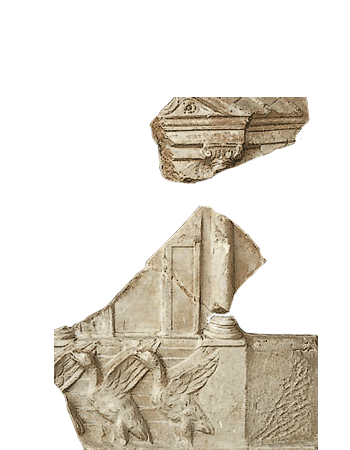
As you wearily climb the last few steps to the summit of the Arx (also called the Citadel), you see an imposing temple dedicated to the great goddess Juno. You can't help but notice the geese, sleek and fat, strolling arrogantly through the temple precinct (to find out how Juno used her sacred birds to save Rome, click on Sacred Geese below). You remember that this temple was dedicated in 344 BCE, in fulfillment of a vow made by the general Lucius Furius Camillus in thanksgiving to the goddess for the Roman victory over the Aurunci, a hostile Italic tribe. This model shows how the temple dominated the city, its height only slightly less than that of the Temple of Jupiter Capitolinus on the other summit of the hill, while this view looks at the temple from the top of the Arx.
Juno was an ancient Roman goddess, identified with the queenly Etruscan goddess Uni (see this detail of an Etruscan bronze mirror back, showing Uni with her hand familiarly and possessively on the shoulder of her consort Tinia, identified by the Romans with Jupiter). This beautiful painted terra-cotta head of Juno, from the pediment of an early fourth-century BCE temple in Scasato, shows her as an elegantly coiffed and jeweled matron wearing a diadem to indicate her divinity. Juno had many titles, most of which stressed her role as protector of the city of Rome, as well as of Roman women. There is no agreement about the derivation of the title Moneta. It may have been an Etruscan word. The Romans themselves were not sure. It may have been associated with mons (mountain) or with monere (to warn); Cicero, for example, says the title was used because a voice had issued from this temple after an earthquake warning the Romans to make an expiatory sacrifice of a pregnant sow (de Divinatione 1.101). Since the Republican mint was located next to this temple, the word moneta came to mean mint and then money. It is also possible that this meaning was primary, and Juno's title derived from her association with the mint of Rome, apparent on this denarius issued by the moneyer Titus Carisius in 46 BCE, or this coin of Hadrian, on which Juno holds scales and a cornucopia.
Since you have already climbed all those stairs, be sure to visit the mint while you are up here so you can see how Roman coins were made. (Note: Scholars do not know exactly where in the city the mint of Rome was located during the Empire, so VRoma has chosen to keep it in this temple precinct.)